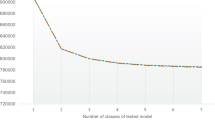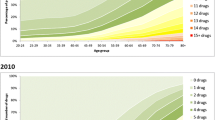Abstract
Objective: Concurrent use of multiple drugs (polypharmacy, PP) may cause health risks such as adverse drug reactions, medication errors and poor compliance. The objective of this study, based on data from a prescription database, was to evaluate estimators of PP in the general population.
Methods: Data were retrieved from Odense Pharmacoepidemiological Database (OPED) and consisted of all prescriptions in 1994 from a 10% random sample of drug users (n=26977) in the county of Funen, Denmark. For each prescription, the period of consumption was calculated by setting the duration of treatment to equal the amount of drug purchased, as measured in defined daily doses (DDD), thereby assuming a daily intake of one DDD. PP was defined as overlapping periods of consumption for different drugs. A Venn diagram was used to illustrate and compare this estimator of PP with two other indicators of multiple-drug use: the number of drugs purchased in 3 months and the mean number of drugs used in 1 year. A receiver operating curve (ROC) was used to evaluate the possibility of predicting episodes of PP from the number of drugs purchased in 3 months.
Results: The proposed estimator of PP was robust towards changes in DDD. On an average day in 1994, the prevalence of PP was 9.9% and the standard deviation (SD) between days was 0.3%. Two to four drugs (minor PP) were used by 8.7% of the population (SD, 0.2%) and five or more drugs (major PP) by 1.2% (SD, 0.1%). The number of individuals displaying PP for the first time in 1994 stabilised after approximately 6 months, resulting in an incidence of major PP of 0.2% and of minor PP of 1.2% per month. For individuals exposed to PP, the median number of days of exposure was 61 and 10.5% were exposed for more than 350 days of the year. Purchase of five or more drugs in the first 3 months of 1994 predicted episodes of major PP in the same year with a positive predictive value of 80%.
Conclusion: Epidemiological measures of multiple drug use can be estimated from data in a prescription database. From a conceptual point of view, an estimator based on the number of simultaneously used drugs (calculated from the date of purchase and the number of DDD) is preferable, but the number of drugs purchased in a 3-month period may also be a useful estimator.
Similar content being viewed by others
Author information
Authors and Affiliations
Additional information
Received: 30 December 1996 / Accepted in revised form: 2 May 1997
Rights and permissions
About this article
Cite this article
Bjerrum, L., Rosholm, J., Hallas, J. et al. Methods for estimating the occurrence of polypharmacy by means of a prescription database. E J Clin Pharmacol 53, 7–11 (1997). https://doi.org/10.1007/s002280050329
Issue Date:
DOI: https://doi.org/10.1007/s002280050329




